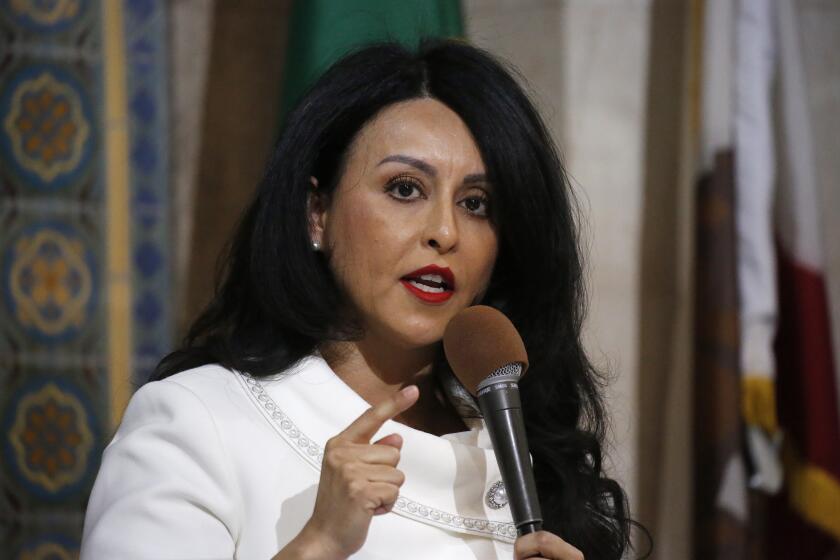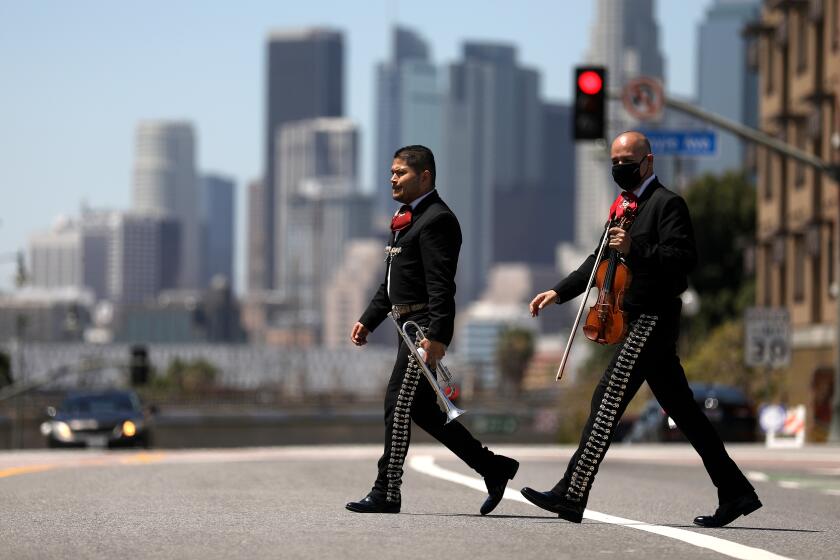Racist audio leak has ‘tainted’ L.A.’s redistricting maps. Now some want them scrapped
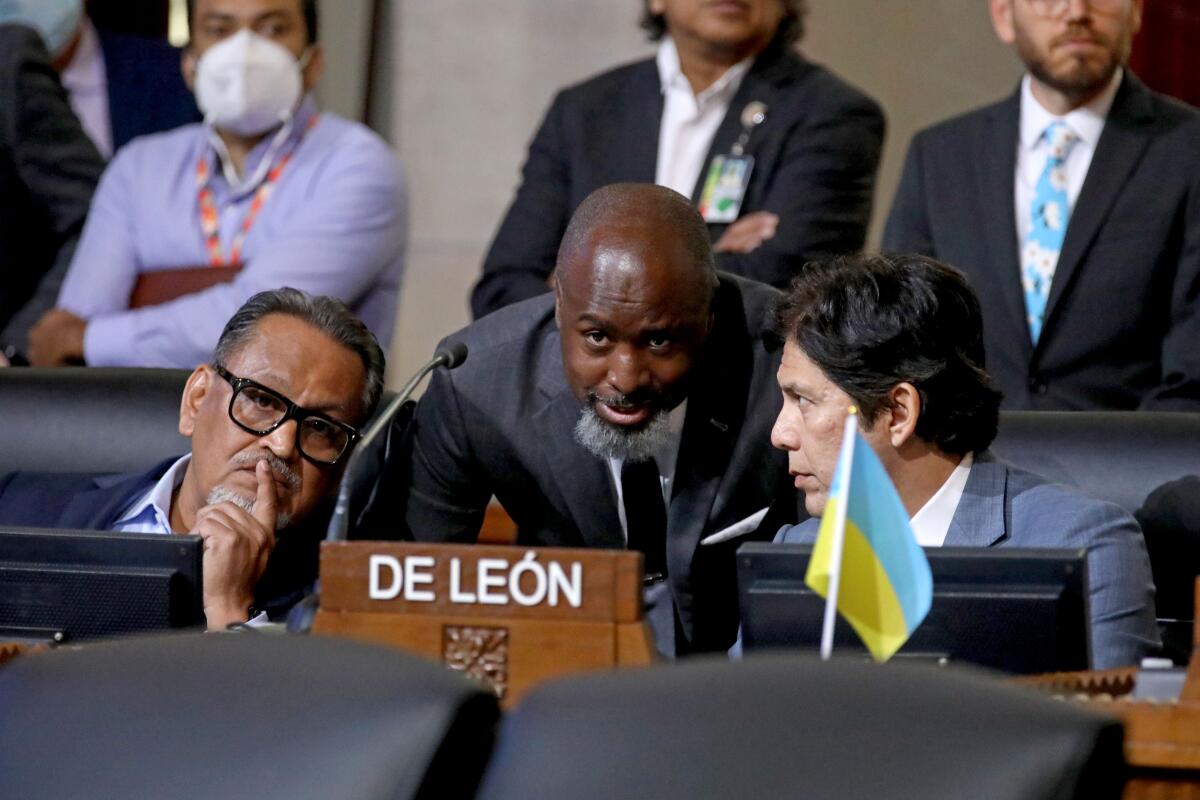
- Share via
For nearly a week, activists and elected officials have demanded the ouster of three Los Angeles City Council members, calling it the only acceptable response to secretly recorded audio of them engaged in a conversation with racist and derogatory language.
But in and outside City Hall, some have begun discussing another, potentially more dramatic step to address the public’s outrage in the wake of the scandal: scrapping the maps of the council’s 15 districts and drawing new ones.
The audio that sparked the uproar captured Councilmembers Nury Martinez, Gil Cedillo and Kevin de León talking about redistricting, the once-a-decade process of drawing new boundary lines for each council district.
During that conversation, they discussed the need to preserve and expand Latino political power while ensuring they and their allies would have districts that help them win reelection. They also sounded exasperated by the continued political might of the city’s Black voters, who make up less than 10% of the populace.
The council finalized its maps in December, two months after the meeting was held.
“I don’t think that these [district] lines are credible at this point in the eyes of many in the city,” City Atty. Mike Feuer said Thursday. “The only way to erase the taint of what was recently disclosed, and to assure the legitimacy of the lines we have, is to redraw them.”
Feuer wants the council to ask voters next spring to authorize an independent commission to create new district maps in time for the March 2024 election. Under his proposal, the council would have absolutely no say in the final product, he said.
Audio of Councilmembers Nury Martinez, Kevin de León and Gil Cedillo speaking with labor leader Ron Herrera quickly became a new and incendiary issue in the Nov. 8 election.
State Atty. Gen. Rob Bonta has announced an investigation by his office into the city’s redistricting process to determine whether there were violations of civil or criminal law. Meanwhile, some who took part in the city’s citizen redistricting commission, which prepared a draft map for the council, are expressing fresh doubts about whether the final boundary lines would withstand a court challenge.
The secretly recorded audio is peppered not only with crude and racist remarks, but blunt assessments of what the three councilmembers and Ron Herrera, then the head of the county Federation of Labor, were trying to achieve at their meeting. All four discussed ways of designing council districts so that they would be favorable to their allies and unfavorable to their rivals.
At one point, Martinez warned Cedillo, who is Latino and represents an Eastside district, that one proposed map could leave him with a higher concentration of white voters and “Berners” — younger residents who voted for Sen. Bernie Sanders for president.
“That does not help you,” she said.
“I’m just trying to get a majority of a good district so that you all can get reelected,” said Martinez, who resigned last week after the audio became public.
Though some are demanding immediate action, others say city leaders need to be deliberate about the type of changes they make to the redistricting process. Moving too quickly to draft a new map could delay the effort to expand the size of the City Council — a change long sought by reform advocates, Councilmember Nithya Raman said.
For the record:
11:48 a.m. Oct. 16, 2022An earlier version of this article said Councilmember Nithya Raman introduced a motion last year to expand the size of the council. The motion, of which Raman was co-author, was introduced last week.
The council is already looking at a proposal, co-authored by Raman last week, to ask voters to increase the size of the council in 2024. If that measure is approved, the maps would need to be redrawn yet again.
“I’m concerned about pursuing one reform in a way that slows progress on another,” she said.
‘Headaches’ for Cedillo
The City Council approved the new district lines in December after reworking a significant portion of a draft map submitted several weeks earlier by a 21-member citizens commission.
The council needed to ensure that each district has roughly the same population. U.S. census figures from 2020 showed that population had declined in neighborhoods stretching from Hollywood to the Eastside. But the numbers had gone up on the Westside and in the west San Fernando Valley.
The census results — declining numbers on the Eastside, increases in the Valley — will create challenges for the panel drawing new maps of the City Council’s 15 districts.
City leaders needed to comply with the Voting Rights Act, which seeks to safeguard Black and Latino representation. At the same time, they had to ensure that race was not the “predominant” factor when drawing the maps. That would violate the equal protection clause contained in the 14th Amendment to the Constitution, the city’s lawyers warned in a memo.
For some, the audio raises new questions about whether race was the dominant factor in the council’s redistricting plan.
On the recording, Herrera told the three councilmembers that the 15th District, which takes in Watts and the Port of L.A., “should be run by union members and Latinos.” Cedillo, who was facing reelection, identified neighborhoods in or near his district that he viewed as a potential problem. All three had been gentrifying, with low-income Latino residents moving out.
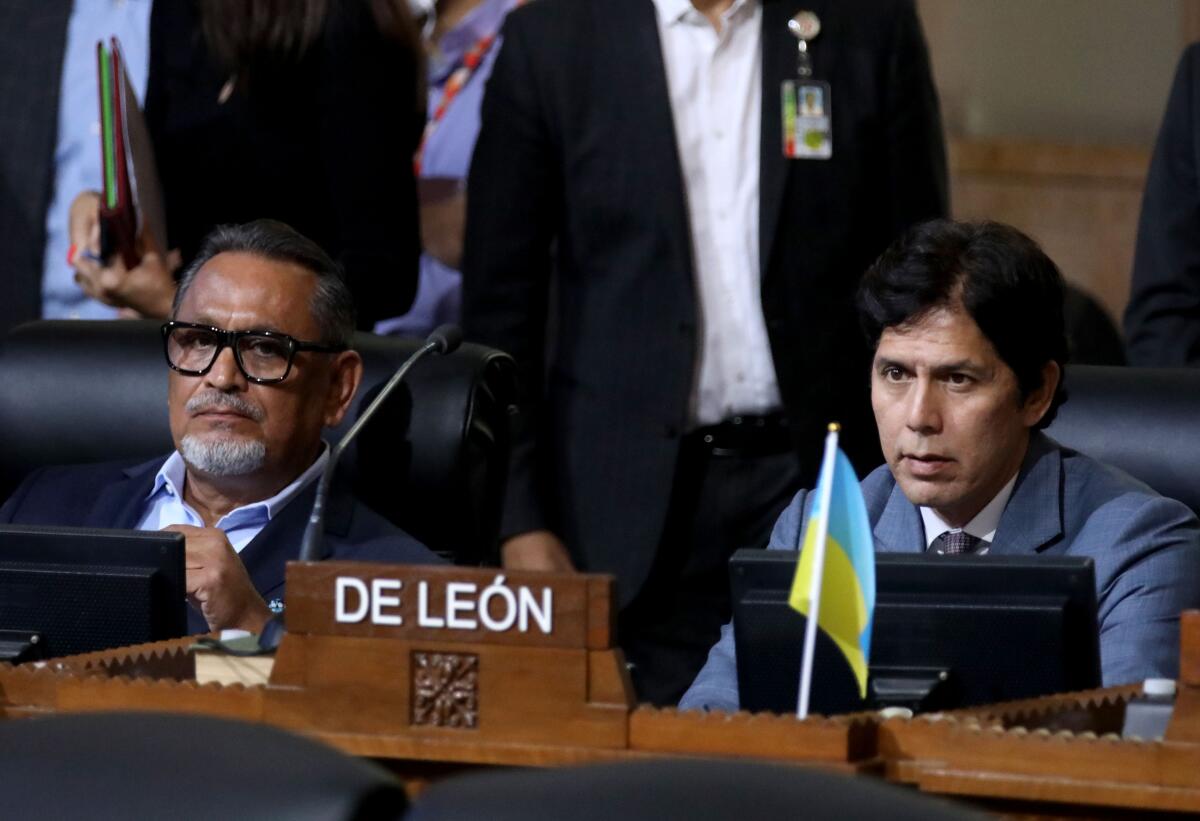
“Elysian Valley is a headache. Eagle Rock is a headache. Highland Park is a headache,” said Cedillo, who represents an Eastside district.
“Elysian, Eagle Rock and Highland Park are white,” De León responded.
‘Tainted’ maps
The conversation also featured attacks on other politicians. Martinez used a profanity while discussing Dist. Atty. George Gascón, telling the group he is “with the Blacks.” She also made racist remarks about Councilman Mike Bonin and his son, who is Black.
“Everything they talk about is, incredibly, through the lens of race,” said Frank Cardenas, who was the executive director of the commission that prepared the draft redistricting map for the council. “They can’t even talk about their colleagues’ families unless it’s through the lens of race.”
Cardenas said he now has serious questions about whether councilmembers made race the predominant factor in their deliberations, in violation of the equal protection clause. “Part of the wreckage that they are leaving behind is ... whether the current council district lines are themselves truly lawful,” he said.
Pastor William Smart, president and chief executive of the Southern Christian Leadership Conference of Southern California, said the public should not have to wait until 2031, when the next redistricting process is set to occur.
“They’ve got to redo them,” he said. “They have been tainted by this group.”
The meeting of the three councilmembers was recorded in October 2021 at the Federation of Labor headquarters, just as the citizens commission — made up of appointees of the mayor, city attorney, city controller and City Council — was putting the finishing touches on its own draft map. At that point, the commission’s draft had drawn furious objections from advocacy groups and even councilmembers.
Progressive activists were outraged at the possibility that Raman, who had been in office less than a year, could lose the vast majority of her Hollywood Hills district, or even all of it. Armenian American civic leaders were appalled at a plan to relocate the district of Councilman Paul Krekorian, who is of Armenian descent and represents neighborhoods in the east San Fernando Valley with a significant Armenian American population.
Unhappy with the way the process was unfolding, Raman replaced her redistricting commissioner with school board member Jackie Goldberg. Councilman Curren Price replaced his appointee with Susan Minato, an official with Unite Here Local 11, the hotel
and restaurant workers union.
Fight over Exposition Park
Minato and Goldberg began pushing for a new map that had major differences from the one the commission had been working on. That alternative map, submitted by the Labor Council for Latin American Advancement, quickly became known as the “labor map.” Several redistricting commissioners said they assumed that it was advanced by the county labor federation, which spends big to elect its favored candidates at City Hall.
The commission did not go with the labor map. But during the meeting at federation headquarters, Herrera and the three councilmembers discussed that map — and proposals for readjusting boundary lines in Highland Park, Koreatown and South L.A., where Councilman Marqueece Harris-Dawson and Price were in a dispute over who should represent USC and Exposition Park.
At the time, supporters of Harris-Dawson argued that USC and Exposition Park should be placed in Harris-Dawson’s district, which has the largest percentage of Black residents in the city.
Supporters of Price said the two facilities should remain in Price’s 9th District, since it is among the most impoverished in the city.
Both Price and Harris-Dawson are Black. Price represents the 9th District, which takes in neighborhoods that hug the 110 Freeway immediately south of downtown. Harris-Dawson represents the 8th District, which is farther west and straddles Western Avenue.
During their recorded conversation, De León said the redistricting commission had become a “Frankenstein’s monster” — a group of political appointees who refused to take instructions from the people who appointed them.
A frustrated Martinez told the group that political appointees should be asking the person who selected them: “What do you need me to do? Because I’m your person. What do you want me to move?”
The councilwoman also spoke of the need to help Price, an ally, get reelected, saying he would need USC and Exposition Park so he could campaign on the issue of job creation. She also told the group it was “insulting” for advocates to suggest that USC and Exposition Park be moved out of Price’s district, which is four-fifths Latino.
That district could easily elect a Latino councilmember in 2026, after Price is termed out, Martinez said. His replacement should not have to lead a district that lacks economic assets, she said.
Activists aligned with Harris-Dawson know the district will have a Latino representative and “don’t want that Latina or Latino to have any assets,” Martinez said.
Councilmembers ultimately kept USC and Exposition Park in Price’s district. They restored a portion of Raman’s district and much of Krekorian’s district. Cedillo’s district was pushed south, into higher-poverty Latino neighborhoods.
The districts represented by three Black councilmembers saw little change.
Race and redistricting
One redistricting expert, after listening to the audio, expressed doubts that the city’s map-making process would run afoul of federal rulings barring the creation of legislative districts that are based predominantly on race.
Four years ago, the city prevailed in a previous lawsuit that alleged that race was the driving factor in the council’s 2012 redistricting process.
That lawsuit, filed by five Korean American voters, relied heavily on remarks made at the time by then-Council President Herb Wesson and one of his appointees on the redistricting commission.
Wesson, who is Black, was recorded on video saying he had fought for a map that would ensure at least two council districts would have a Black representative for the next 30 years. His redistricting commissioner, Christopher Ellison, wrote in an email about his efforts to keep Wesson’s South Los Angeles district as a “predominantly African American opportunity district.”
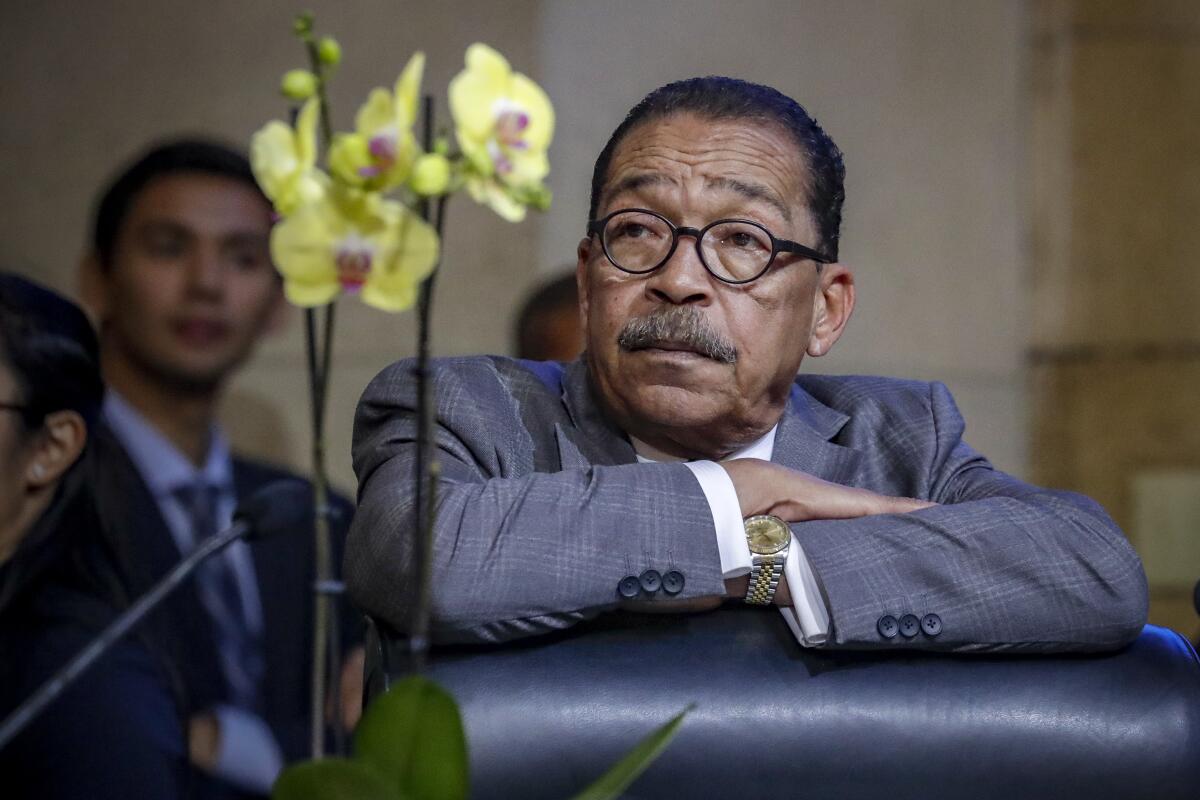
The 9th Circuit Court ruled in favor of the city, concluding that race was not the predominant factor in designing the final map. Wesson and his appointee were just two among many who had influence over the line-drawing process, the court wrote.
Attorney Kevin Shenkman, an expert on redistricting, said he believes a legal challenge against L.A.’s latest set of district maps would probably meet the same fate. Shenkman, who regularly litigates cases dealing with the state Voting Rights Act, said the link between race and redistricting was actually more explicit in 2012 than in the secretly recorded audio.
“Frankly, Councilmember Wesson’s remarks were even more direct about what he was doing than Nury Martinez’s remarks,” he said. “Nury’s were more vulgar. Herb’s were probably more direct, and the 9th Circuit said no, that’s not an equal-protection violation.”
Sara Sadhwani, who served on the state’s redistricting commission, said she too listened to the recording and did not hear anything illegal. The three councilmembers were looking to protect themselves and their allies — which they had the authority to do, since the City Charter grants them final say on the maps.
Sadhwani, an assistant professor of politics at Pomona College, said the state redistricting commission also had different communities “jockeying for power” as the maps were being drawn. That process took place in public and didn’t include racist comments, which Sadhwani condemned.
“What you hear” in the audio of the three councilmembers, Sadhwani added, “is they’re jockeying for themselves.”
Cardenas, who served last year as the redistricting commission’s executive director, said he sees race and the bid to protect City Hall incumbents as inextricably linked in the recording.
“I know some people are saying it’s about race. I know some people are saying it’s about power. I’m saying it’s about both,” he said.
More to Read
Sign up for Essential California
The most important California stories and recommendations in your inbox every morning.
You may occasionally receive promotional content from the Los Angeles Times.
